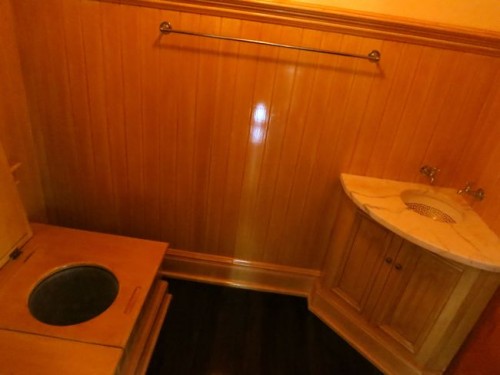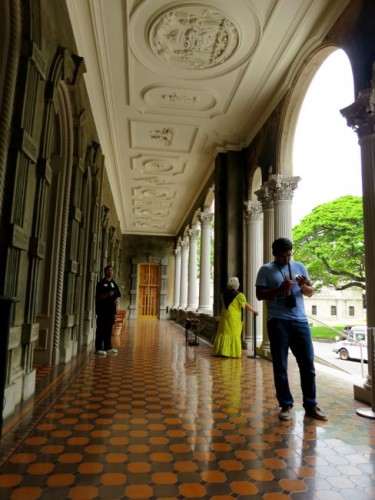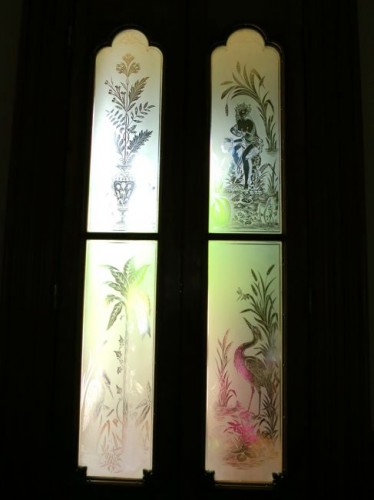Hawaii today is the 50th state of the United States of America, but in the 19th century it was an independent monarchy, recognised by all the major powers in the Pacific.
Despite the proximity of the United States, and the influence of New England missionaries, the Hawaiian monarchy continually looked to Europe as a model. In 1824 the 2nd king of the Hawaii was the first to travel to Europe, and while his trip ended badly, the Hawaiian fascination with travel and Europe continued. Queen Victoria was godmother by proxy to the only child of Kamehameha IV. Kamehameha V had travelled extensively in the US and Europe before becoming king.

Kamehameha II and his Queen, who both died on their 1824 trip to England
In 1881 King Kalakaua became the first monarch (of anywhere, not just Hawaii) to circumnavigate the globe as he visited Japan, China, Siam, India, the US, and pretty much of all of Europe. In Europe Kalakaua was extremely taken with the grand palaces of the European royalty, and was determined to build a grand palace in Hawaii. While in Europe he ordered furnishings, and on his return work went full speed ahead.
‘Iolani Palace (Royal or Heavenly Hawk Palace, named for Kamehameha V) was completed less than two years later, for a total cost of $340,000 (an absolute fortune at the time – not the best financial decision for the island kingdom). The palace was the grandest building in the Pacific, and a triumph of architecture and modernity. Built in an architectural style referred to as American Florentine, it could more accurately be called Hawaiian Renaissance, as ‘Iolani Palace specifically references Roman-based Italian Renaissance architecture with Hawaiian touches, and is the only example of American Florentine architecture in the world. It featured indoor plumbing, electricity and telephones – the last two well before they were installed in the White House.

The grand koa staircase in the Great Hall of ‘Iolani Palace
Electricity and telephones were so rare in the early 1880s that the palace had to run its own electrical system, and the telephone was used almost exclusively to call the electrical engineer and let him know that he could shut down the generator for the night. Hawaii had no general telephone system so there was no-one outside the palace to call!

The Blue Room, where Lili’uokalani played music
While the electricity and telephone weren’t able to be used to their full potential, they were much admired by the diplomats and visiting notables who attended glittering balls and receptions at the royal palace, dancing to the strains of popular tunes played by the Royal Hawaiian Band as they were cooled by trade winds that blew through the clever vented windows, or listening to Princess Lili’uokalani (later Queen) play one of her compositions at the beautiful piano in the Blue Room. I’m sure they appreciated the indoor loos as well!

An 1880s toilet just off one of the downstairs reception rooms, ‘Iolani Palace
Sadly, the palace was the royal residence for just over a decade. The descendants of the American missionaries who played such a part in Nahi’ena’ena’s sad story resented the Hawaiian ties to England over the United States had been gradually undermining the Hawaiian monarchy’s power. In 1893 they staged a coup and overthrew the monarchy. They initially turned Hawaii into a Republic and imprison Queen Lili’uokalani in her own palace, before convincing the United States to annex the Kingdom in 1898. The Kingdom was no more, and the palace became an office building.

The Grand Hall of ‘Iolani Palace, looking towards the Throne Room
In 1969 the process of restoring the Palace began, and a decade later it was opened as a museum. Restoration continues today, with the downstairs kitchens and office rooms being the most recent restoration project. Another major part of the restoration is the search for the original furnishings. A dedicated group of amateur historians haunt auction catalogues and antique stores looking for the scattered glory of the lost kingdom. Pieces have been found across the world: in the US, across Europe, and even in New Zealand. One tourist visiting the palace looked at a photograph of the Kings bedroom in its original condition, and realised that the lost table shown in the photograph was in his own living room!

Precious vases given by the Chinese Ambassador, and portraits of former royalty – all located and returned to their home
Despite growing up in Hawaii, I’ve only visited the palace twice – once on a Girl Scout trip, and then again on my last trip home. I’d remembered from my first trip that photography was strictly forbidden at the Palace, but I decided to visit it anyway, and attempt to blog about it for you without images.
Sitting on the front lanai (veranda), waiting for my time slot to go in I confirmed the ‘No Photography’ rule with one of the hosts, and was told, to my absolute delight, that the rule had just changed, and they hadn’t had time to take down the signs or change the pamphlets.

The grand lanai of ‘Iolani Palace
Oh delight! Oh joy! I was going to document everything and show you all of it!
Like the front doors, with their frosted glass, designed and made in San Francisco by artists who tried to incorporate Hawaiian imagery without every having seen the plants and people they were illustrating. The end result is amusing, to say the least:

The front doors, ‘Iolani Palace
And the fabulously Victorian carpet in the Dining Room, carefully reproduced based on the original:

The Dining Room carpet, ‘Iolani Palace

The Dining Room, looking back into the Blue Room, ‘Iolani Palace
And then, after only three rooms (the Great Hall, Blue Room & Dining Room), my camera batter died. I hadn’t even got to the really interesting and Hawaiian bits, like the Throne Room, and the upstairs bedrooms, where Queen Lili’u was held prisoner!
No worries though, I had another one in my camera bag!
Nope. It was back in my luggage in storage for the day. Grrrrrr!
So you’ll just have to enjoy the three rooms I did photograph, with their fascinating mix of Victorian taste, Hawaiian tradition, and attempt to create a royal palace in the furthest outpost of the world at the end of the 19th century.

Grand furniture in the Dining Room, ‘Iolani Palace
The Hawaiian touches are subtle: louvered windows to let in the sea breezes, native woods throughout.

Royal Portraits and a reclining chair in the Blue Room
The Victorian taste is very evident: the too elaborate furniture and carpets, the crowded walls, the dark colours.

The Dining Room from the doorway of the Blue Room, ‘Iolani Palace
The Royal touch is there in the portraits, the gifts from diplomats, and the juxtaposition of private residence and government building.

Kamehameha the Great and one of his Queens, ‘Iolani Palace
Sadly, it is the upstairs, which I was not able to photograph, that best conveys the triumph and tragedy of the Hawaiian monarchy. On the one side there is the King’s Bedroom, where Kalakaua played raucous games of poker and won hands by claiming that four kings beat four aces, because when he held them there were five kings.
On the other hand, and across the hall, there is the room where Lili’uokalani was imprisoned after a failed counter coup, and where she created a quilt that combines Victorian crazy quilts with a defiant statement of Hawaiian sovereignty.
And haunting the whole upstairs is the sense that the building was a very adult building: there were so few bedrooms, all so large and grown-up. There was no nursery. There were no children. The last princess grew up elsewhere. She never got to live in the Palace, to have children that could be heirs, that could fill the palace with laughter and joy and leave fingerprints on the pristine staircase.

The grand koa staircase in the Great Hall

Wonderful – full of a sense of the light and so spacious. Never even heard of this place! A pleasant, airy alternative to some of the National Trust propeties I’m used to in the UK!
I’d love to see that one day!
Gorgeous photos- If I ever get to Hawaii, this is definitely on a “must-do” list!
Wow. That’s impressive. You’ve given me something to visit if I ever get to Hawai’i. Thank you!
What a fascinating place. Thanks for sharing your visit. Now you will have to go back and photograph the rest.
Just last week I read an article that reported that many museums are rethinking their no photos policy. With most everyone who visits having a camera in his pocket, some museums realized that the guards were so focused on busting photo-takers, that they did see people who were touching the artifacts. And I think some museums have come to realize that with so many photos ending up on the internet, that the free publicity is worth the lost postcard revenue.
Opps! make that “…they did NOT see people…”
Your posts just continue to surprise and delight me! My knowledge of Hawaian history is patchy, and I had no idea that this wonderful, unique building existed.
The mixture of tradition and ‘modern’ technology is especially interesting. I reminds me of one of Ludwig’s palaces, the one at Herrenchiemsee, I think, where the formal dining table sinks through the floor, enabling the table to be re-set between courses, and probably to serve the food hot. I kept having visions of the toes of dignitaries dangling over the gulf – one would hope they went for a little walk between courses.
How interesting! And isn’t it so cool to get a history lesson??
Hawaii is pretty small and insignificant in the big scheme of things – few people know much about its history.
I’m trying to envision how the table works. When you sit at a table you scoot under it, so you’d have to pull all the chairs back to let the table sink into the ground.
Interestingly Hawaii also has Shangri-La, the fantastic 40s house built for Doris Duke – it has huge glass windows that sink into the floor so that you can walk straight from the lounge onto the patio during parties. Way flasher than sliding doors!
Thank you for this fascinating article. I love the part about the phone. It’s so interesting to hear your Hawai’i stories.
You’re welcome! I’m really pleased that these translate, and are interesting. I worry that I can be too detailed, and too obscure, because I know so much about Hawaii and there can be so many names and so much cultural stuff!
This was so exciting and informative to read! I love your Hawaii posts, because it’s so great to get to know the real Hawaii. Which sounds rather cliche-ish itself… but I mean it!
I’m glad you enjoyed it! I love sharing what Hawaii is really like, and what NZ is really like.
Love the carpet. I will have to add Hawaii to my list of places to see.
I had no idea that such a beautiful palace was even there.
Before your articles the most I knew about Hawaii was the volcanoes that had red hot lava coming out , big waves for surfing and Honolulu had the international airport. At school all we learned about Hawaii was that the Maori people paddled their canoes from there to New Zealand.
So keep these articles coming.
Well, volcanos, surfing and an international airport are better than what most people know! I still remember being 9 and having someone on the Mainland US asking me how long it took to drive to Hawaii. And then there was the time I was asked if I had heard of TV… Or lived in a grass shack… Or spoke English…
The Maori didn’t come from Hawaii (and they wouldn’t have paddles – they use masted sailing waka, it’s way too far to paddle). The Maori, like the Hawaiians and the rest of the Polynesians, came from Hawai’iki – the ancestral homeland, beyond the horizon to the West. Hawaii is named after Hawai’iki. More recently both the Maori & Hawaiians, along with the Tahitians, came from the Marquesas Islands. The Hawaiians also had a later wave of immigration directly from Tahiti. This is why Te Reo Maori, Ka Leo Hawaiian, and the Tahitian language are so closely related.
How wonderful! I never heard of American Florentine architectural until your post. I’ve sewn a couple florentine renaissance gowns, and thought my only chance to see this style in its glory was to visit Italy – which if I’m lucky will be in Feb 2014.
If I don’t make it to Italy, I will be visiting Hawaii for the first time in Oct 2014. It’s a trip we’ve wanted to take for a couple years now. I just told my husband about the palace, and he said it’s going on the list. *happydance*
Thank you for sharing.